RECOIL OFFGRID Gear Northwoods Stalking Bag: A Pack Prepped For Chilly Hunts
In This Article
Here in my home state of Michigan we get our share of snow in the winter months — however, you may fall asleep to snow and wake up to rain and mud. If you want to enjoy the outdoors, you’ll need to be prepared to play whatever hand nature deals you. When I’m stepping off into wild areas or prowling for game animals, I like to keep things as simple as possible, which means taking the same gear with me regardless of the duration of the trip. The chance of getting turned around on a hike or a stalk — as much as you can attempt to stalk in Michigan — means taking your gear with you when you’re in remote or unfamiliar territory. This Northwoods Stalking Bag was built to ensure everything I need is with me and accessible.
The base of my winter kit is a 5.11 Tactical Rush 72-hour pack. Ripe with exterior pockets and lots of internal zippered organization, its overall size is enough to take everything I need with extra space for some of what I want. I’m careful not to buy big packs because I tend to fill them with gear I don’t really need. Having a sternum strap and a padded waist belt is recommended for a pack this size, as it allows you to shift weight from the shoulders to the hips to fend off fatigue.
Sleeping gear takes up the bulk of the main compartment. I’ve grown very particular about what I’ll use for sleep systems. The gear must be easy to set up or stow in darkness or low-light conditions with cold fingers or gloves. This typically steers me away from the use of a tent.
For my money, nothing beats an insulated Klymit inflatable sleeping pad. You need something to insulate yourself from the ground to keep from losing heat via thermal conductivity. It takes less than a minute to fully inflate, it rolls up nicely, and I find it comfortable enough to get a good night’s sleep when paired with one of Klymit’s inflatable pillows.
Enlightened Equipment makes a variety of excellent sleeping bags and quilts. I like the APEX 20-degree quilt with a synthetic fill. The end is able to be cinched off or opened up in case you need a little air flow. I’ve found 20-degree bags to be a good cold weather option for overall comfort and packability. It’s important to point out that the terms “warm” and “comfortable” are relative. What is not relative is hypothermia. You may find that you’re cold in a 20-degree bag, but you probably won’t freeze to death in it. Comfort is what I find to be good enough to allow me a few hours of sleep at a time. I’m not getting Tempur-Pedic sleep in the woods.
Down is great if you’re sleeping in a tent or a cozy cabin, but once down gets wet it has lost its ability to insulate and keep you warm. You might think, “So don’t get it wet. Make a better shelter.” Even in the cold, sometimes it’s humid enough to kill the insulation quality of down. I slip the sleeping pad and quilt into a Snugpak bivy and place it under a tarp or a lean-to structure depending on the weather.
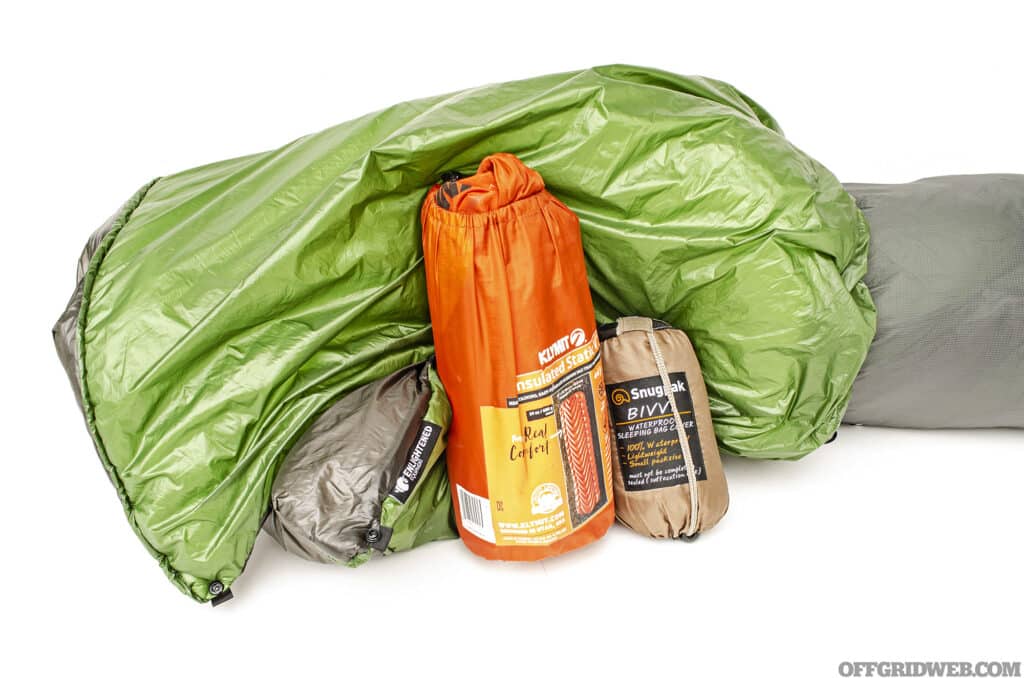
Above: An emergency sleep system can transform an emergency into an inconvenience.
An extra watchman’s hat, clean Merino wool socks, and fresh underwear stored in Ziploc gallon-size freezer bags are at the bottom of the main compartment. They’ve always been a welcomed morale boost at the end of a long day to change into before to bed.
A SOL Survive Outdoors Longer bivy just in case I get dealt a very bad hand.
A Defense Mechanisms Hand Warmer waist-mounted pouch is perfect to keep your hands warm when you’re stationary or taking a break. The pocket in the front is great to tuck a couple chemical hand warmers in to kick up the heat.
Two or three contractor trash bags. The thicker mil bags are tough as nails and have dozens of uses.
In a zipped inner compartment, I keep a medical kit. My medical pouch is very basic. Keeping a stack of different sized bandages and blister covers, Tylenol or Advil, a roll of antacid tablets, anti-diarrheal pills, and a few Liquid IV packets has proven to be useful on more than one occasion.
A BIC lighter in an Exotac protective container wrapped in Gorilla Tape. The tape is great for repairs and starting fires. As a matter of fact, I keep a BIC lighter wrapped in tape in every pocket of my pack and one in my Kit Bag. They’re inexpensive and light enough that it makes sense.
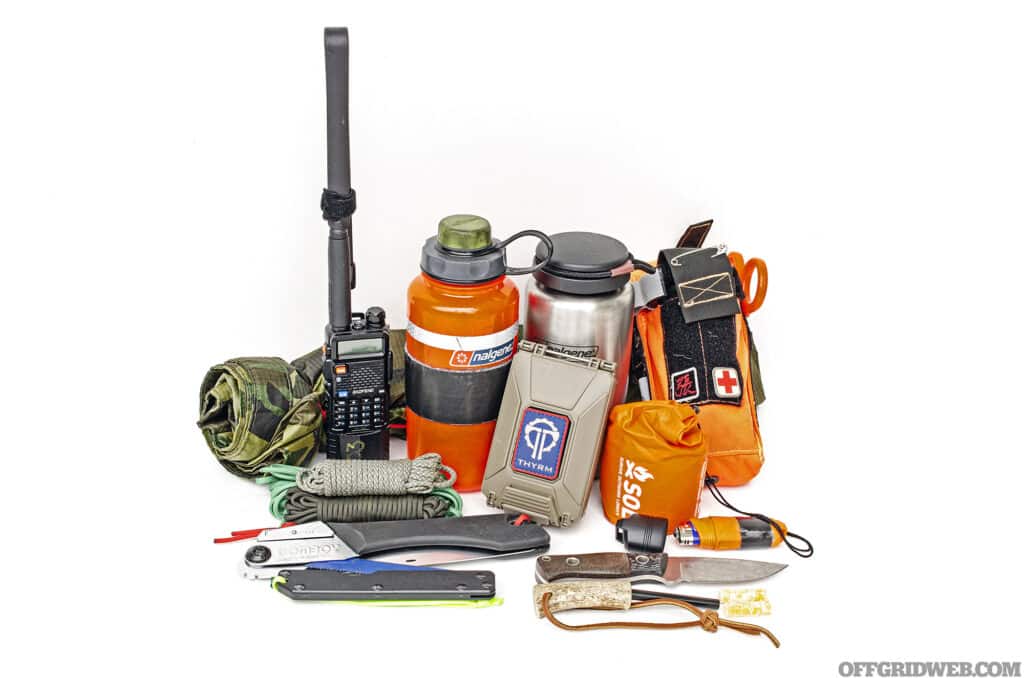
Above: I’ve never needed all of this gear in a single situation, however I have needed every item at one time or another. After spending one cold unplanned night in the woods, you’ll be glad to have some extra supplies.
I include a HellFire Bushcraft stainless steel grill, because sometimes Mountain House or MREs aren’t exciting to me, or I’ve successfully hunted something.
Side storage pockets hold a titanium 20-ounce Snow Peak cup and lid, a handful of instant coffee packs, a Jet Boil with extra can of fuel, and an extra broken down MRE main meal.
The small upper pocket has gallon-size freezer bags and exam gloves for cleaning wild game.
The pack’s Shove-It Compartment between the body and rear-facing flap — originally designed to carry a helmet — is usually reserved for hauling something I’ve hunted or found along the way.
There’s is an extra knife, foldable Silky Saw, LifeStraw water filter, book, several lengths of 550 cord, extra cold weather gloves and exam gloves, and a Petzl headlamp with high, medium, low, and red light settings.
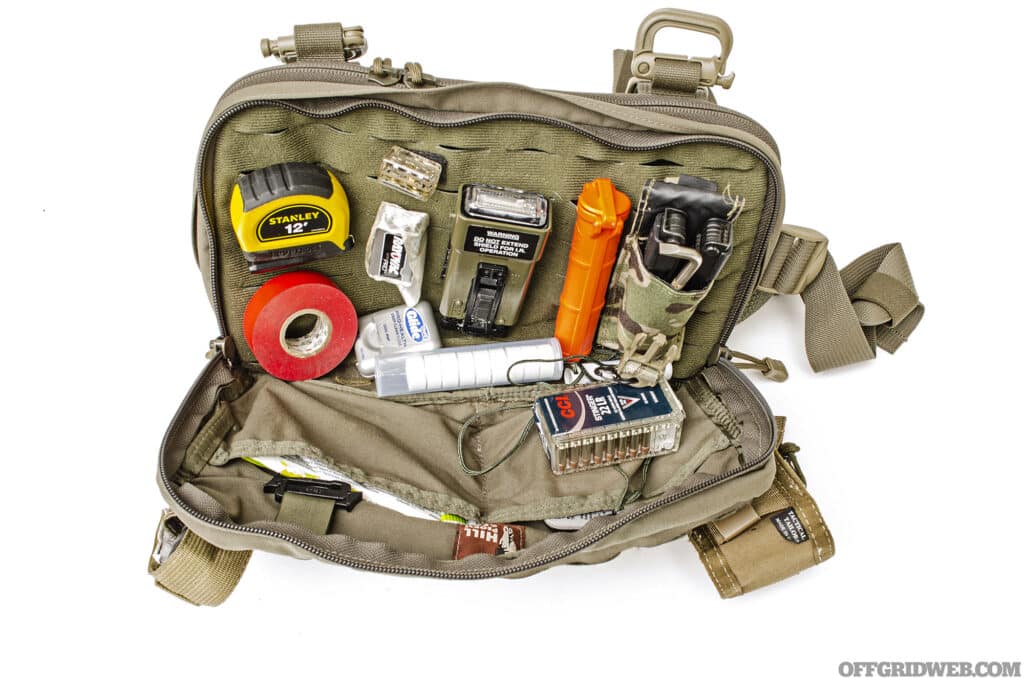
Above: A chest rig is great for keeping vital tools close and accessible.
I’ve always got a Thyrm CellVault-5M mounted to the webbing of the front pocket. Make sure any batteries you take into the cold are lithium ion as they’ll withstand the cold better than alkaline. If it’s really cold, put them inside a coat pocket so your body heat will help protect them.
On the bottom of my shoulder strap, I keep a Dark Angel Medical direct action response kit (D.A.R.K.), not to be confused with a basic medical kit. Given the speed blood can leave the body, a trauma kit needs to be always at the ready. Trauma kit bare minimum requirements are a tourniquet, hemostatic gauze, chest seal, a roll of standard gauze, and an emergency blanket.
Along the base of the pack, I stash 30 feet of 1-inch nylon tubular webbing daisy chained with two climbing grade rings. If you’ve ever pulled a deer up a hill, you’ll understand.
Two Nalgene water storage containers are housed in Spiritus Systems pouches. One of my bottles is the usual plastic fantastic with 4 to 6 feet of Gorilla tape wrapped around it, the other is single-walled stainless steel. Should the water freeze, the steel container can be set near a fire to melt. Keep in mind that single walled steel — not dual walled/vacuum insulated — is the only option for direct heating over fire.
Ranger beads are tied to my shoulder strap for tracking distance traveled while navigating.
It may not be the ideal place for a knife, but while wearing a padded waist belt from the pack, I like my Bradshaw Blades fixed blade knife mounted to my shoulder strap ’80s style for easy access.
Camp axes and tomahawks have proven to be an indispensable piece of gear both for shelter building and processing firewood. The Wenger Blades Loki has been a great addition to my hunting pack.
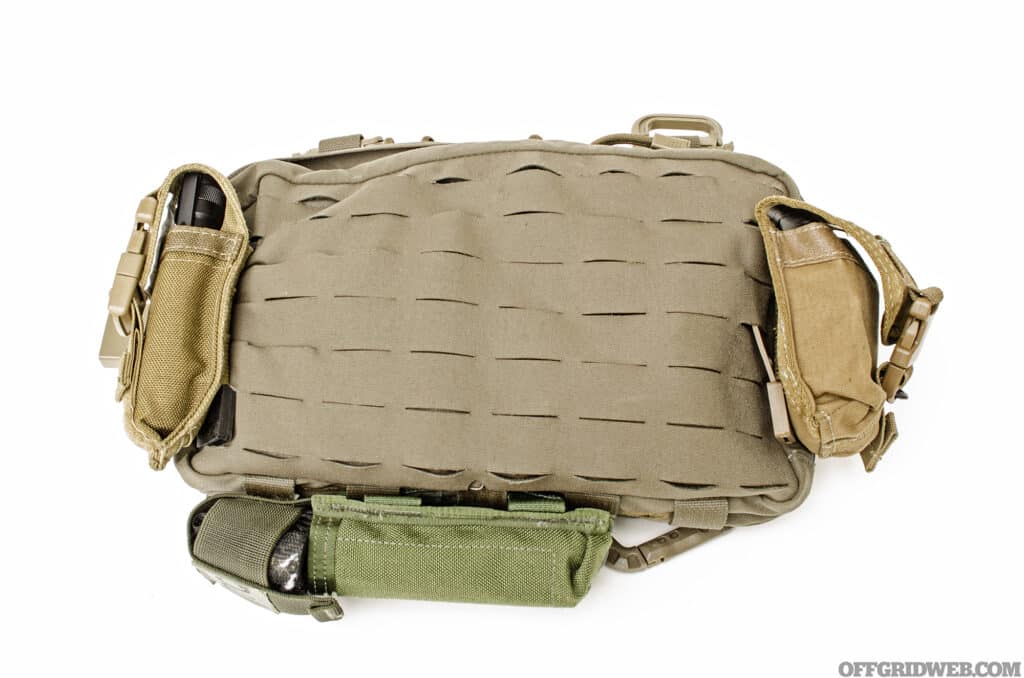
Above: I never go into the woods without a Hill People Gear Kit Bag. This little chest rig keeps my pants and coat pockets available for warming my hands, and ensures high-usage items are readily available.
Carried across my chest, this pouch allows me to quickly access small, frequently used items. It can also serve as an emergency sustainment kit should I become separated from my main pack. It contains my area maps and map tools, compass, ham radio and extra battery, 25 feet of 550 cord, a Gerber multi-tool, small tape measure, travel-size dental floss, Chapstick, a sleeve of Compawipes, IR beacon and 9-volt battery, extra ammunition for my rifle or shotgun, red electrical tape, BIC lighter wrapped with tape, SOL emergency blanket, Streamlight ProTac 2L-X flashlight, CAT 7 tourniquet, and a ferro rod from SouthPaw Knots.
Over the years I’ve found this to be a good set up for me. Make sure you test all your gear before you bet your life on it. Any time you’re heading into the woods or wild parts, let someone responsible know where you’re going. Show them on a map and circle the area. Set up regular communication windows with them as well. Remember that comfort is relative. Have an adventure with campfires, chilly nights, and beautiful snowy days, then come home to truly appreciate your furnace.
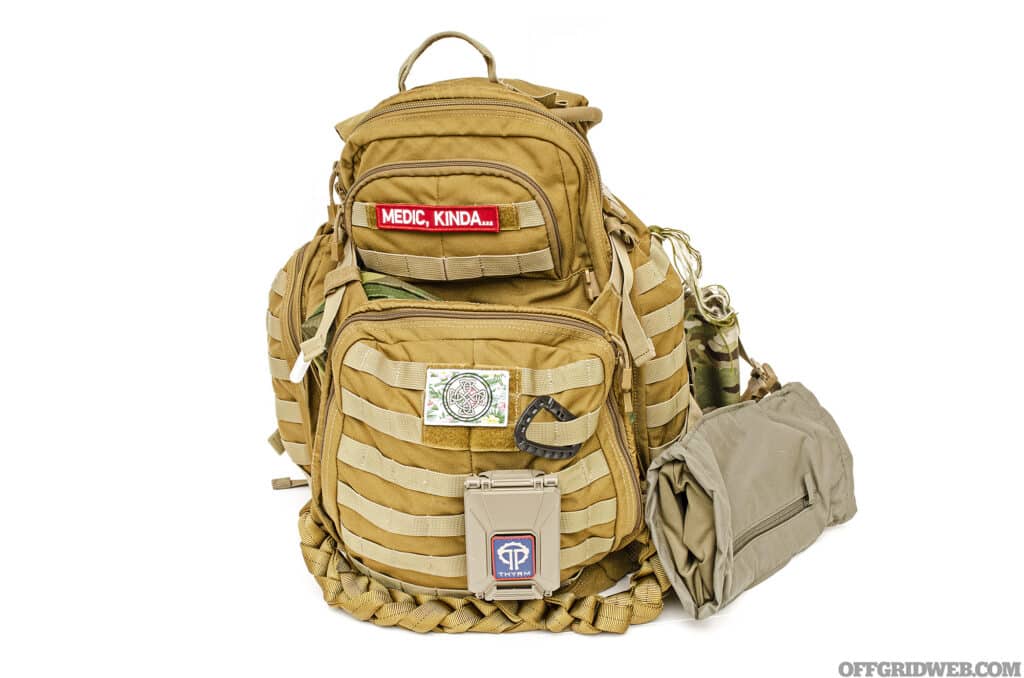
Subscribe to Recoil Offgrid's free newsletter for more content like this.
Editor's Note: This article has been modified for the web from its original print version.

 STAY SAFE: Download a Free copy of the OFFGRID Outbreak Issue
STAY SAFE: Download a Free copy of the OFFGRID Outbreak Issue
No Comments